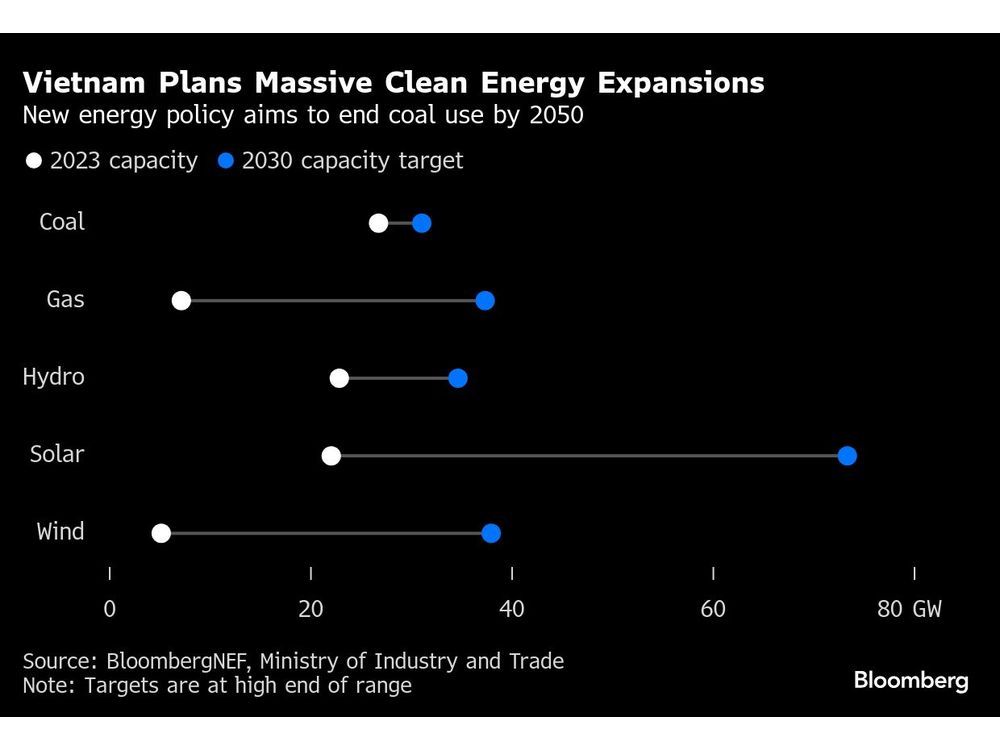Vietnam’s government has approved a revised energy policy that calls for massive increases in wind and solar capacity as it seeks to keep pace with growing power demand while ending the use of coal by 2050. Author of the article: You can save this article by registering for free here . Or sign-in if you have an account.
(Bloomberg) — Vietnam’s government has approved a revised energy policy that calls for massive increases in wind and solar capacity as it seeks to keep pace with growing power demand while ending the use of coal by 2050. Subscribe now to read the latest news in your city and across Canada. Subscribe now to read the latest news in your city and across Canada.

Create an account or sign in to continue with your reading experience. Create an account or sign in to continue with your reading experience. Sign In or Create an Account The latest amendments to the Power Development Plan VIII, approved by the government earlier this week, call for the nation to more than double its total generating ability by 2030 from 2023 levels, with the aim of increasing capacity nearly 10-fold by 2050.
Officials expect power demand to soar as they aim for economic growth of at least 8% this year and double-digits through the end of the decade. The clean energy targets far outstrip what analysts expect the country to be able to achieve. The roadmap calls for as much as 73 gigawatts of solar and 38 gigawatts of wind by 2030 — but BloombergNEF forecasts that the country will have about 32 gigawatts of solar and 12 gigawatts of wind by then.
By 2050, Vietnam is targeting as much as 230 gigawatts of wind and 296 gigawatts of solar. Get the latest headlines, breaking news and columns. By signing up you consent to receive the above newsletter from Postmedia Network Inc.
A welcome email is on its way. If you don't see it, please check your junk folder. The next issue of Top Stories will soon be in your inbox.
We encountered an issue signing you up. Please try again Interested in more newsletters? Browse here. “The plan can deliver clean energy security for Vietnam,” said John Rockhold, head of the Vietnam Business Forum’s Power and Energy Working Group.
“The government has the laws and decrees in place. The question now is can the energy developers and investors — both state-owned and private — deliver within the timetables.” Vietnam’s power sector currently relies on coal for nearly half its generation, but wants to turn away from the fuel.
In 2022, it signed a multi-billion agreement with the US and other governments and banks to expedite that process. Vietnam’s energy roadmap now calls for construction of a handful of new coal power plants through the end of the decade before switching them to burn biofuels or ammonia by 2050. Natural gas may get a boost in the near term, with capacity expected to increase more than five-fold by 2030, powered mostly by imported liquefied cargoes.
The pipeline for those power projects is well behind schedule, according to BloombergNEF. The plan also calls for the country to bring online its first nuclear power plants between 2030 and 2035. Vietnam hopes to piggyback on a recent string of cross-border power deals in Southeast Asia, with the aim of exporting electricity to Cambodia, Malaysia and Singapore.
Postmedia is committed to maintaining a lively but civil forum for discussion. Please keep comments relevant and respectful. Comments may take up to an hour to appear on the site.
You will receive an email if there is a reply to your comment, an update to a thread you follow or if a user you follow comments. Visit our Community Guidelines for more information..
Top

Vietnam Eyes Huge Wind and Solar Farms to End Coal Use by 2050

Vietnam’s government has approved a revised energy policy that calls for massive increases in wind and solar capacity as it seeks to keep pace with growing power demand while ending the use of coal by 2050.











-1745121369054_v.webp)